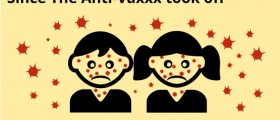
We have all heard stories how vaccination is incredibly important for us, keeping us safe from various diseases which can possibly affect us. However, vaccines have often been involved with various matters of controversy, often being considered harmful or useless, used by the pharmaceutical industries for no other purposes but making profit.
So, this ambivalence of vaccines and vaccination per se makes us cautions when it comes to this subject. However, we can always expand our knowledge and understanding of vaccines through getting more and more informed. For this purpose, read the lines below and learn all you need to know regarding vaccines and the positive and negative sides of vaccination.
Why Is Vaccination Important?
By definition, vaccination is the process of administering antigenic material in order to boost our immune system, helping it fight off various diseases effectively. Therefore, the main purpose behind vaccinations is preventing infections.
Different vaccines keep us safe from different diseases. For example, the flu vaccine prevents influenca infections while the chicken pox vaccine deals with the eponymous disease. Hence, this form of prevention is considered to be the best possible one.
Additionally, some of the main purposes behind vaccination is keeping diseases under control during the times of epidemics and similar occurrences. Commonly, vaccines have helped people exterminate certain types of illnesses they were prone to, becoming completely immune to these. Such was the case with small pox. So, today, we do not need the small pox vaccines since the disease is completely gone.
Keep in mind that the more dangerous a disease is, the more people need to get vaccines in order to keep the epidemics at bay. Today, measles is a condition considered to be one of the most infectious ones. Therefore, if people stopped taking shots for measles, the disease would spread once again at an abnormally fast pace. Thus, the vaccination will stop once at least 90% of newborns are immune to measles. Furthermore, if the 95% of children become immune, this would be a giant step towards overcoming the immunity problem of mumps and rubeola too.
Children obtain this, so-called, passive immunity from the antibodies their vaccinated mothers transfer to them during the pregnancy. However, this immunity usually last only for a month at most. After this period the MMR vaccine needs to be administered in order to keep the children protected.
Quite interestingly, the process of producing vaccines starts from producing the disease-triggering organism itself. Basically, the scientists need to create the bacterium or the virus themselves, altering these so that they cannot trigger diseases. Then, once a person receives these kinds of microorganisms, he/she becomes immune to the actual virus or bacterium.
Types of Vaccinations
Four different types of producing vaccinations are currently considered to be the most practiced ones. First of all, there are inactivated vaccines, which are made from virus or bacteria which were killed by heat or formaldehyde. The human organism, once it receives these dead virus and bacteria, recognizes them and develops its immune system against them, without being harmed beforehand. These vaccines do not contain replicating organisms. Thus, additional shots are necessary for boosting one's immunity completely.
Attentuated vaccine is the second type, being a vaccine which contains viruses or bacteria which are of low virulence. So, these organisms are capable of replicating, even though this process is quite slower than the actual one. Subsequently, additional vaccinations take place less often with these vaccines.
The third type of vaccines involves those which consist of viral proteins taken from structural proteins of certain viruses. These proteins can make a structure which greatly resembles an actual virus. Yet, these are not infectious. Therefore, these proteins can be injected into the human body, helping it develop its immunity without getting infected.
Finally, a sunbunit vaccine is a type which does not involve exposing the human body to any form of virus or bacterium. Rather, only the toxins or specific proteins are injected. However, this method is often considered ineffective, due to the fact that the human organism may not be capable of recognizing the microorganism behind the toxin, and do develop its immune system.
Is There any Risk Involved?
Most commonly, some people who receive vaccinations react mildly to this form of exposure. Typically, a swelling would affect the place of injection, disappearing after a short while. Babies and small children may not feel so well after the vaccination or maybe experience a small rise in body temperature. However, this too passes over a short period of time, lasting for two days at most.
Yet, more serious side-effects can be expected to appear in people who are allergic to certain types of vaccines. Here, the anaphylactic shock may lead to total collapse or severe breathing difficulties and the necessity for immediate medical assistance. Fortunately, these reactions are very rare and happen less than once in million vaccinations.
All in all, vaccines are incredibly important for keeping diseases at bay and boosting your body's immunity to diseases. Therefore, you are advised to undergo vaccinations regularly and apply the same practice for your children.

















Your thoughts on this
Loading...